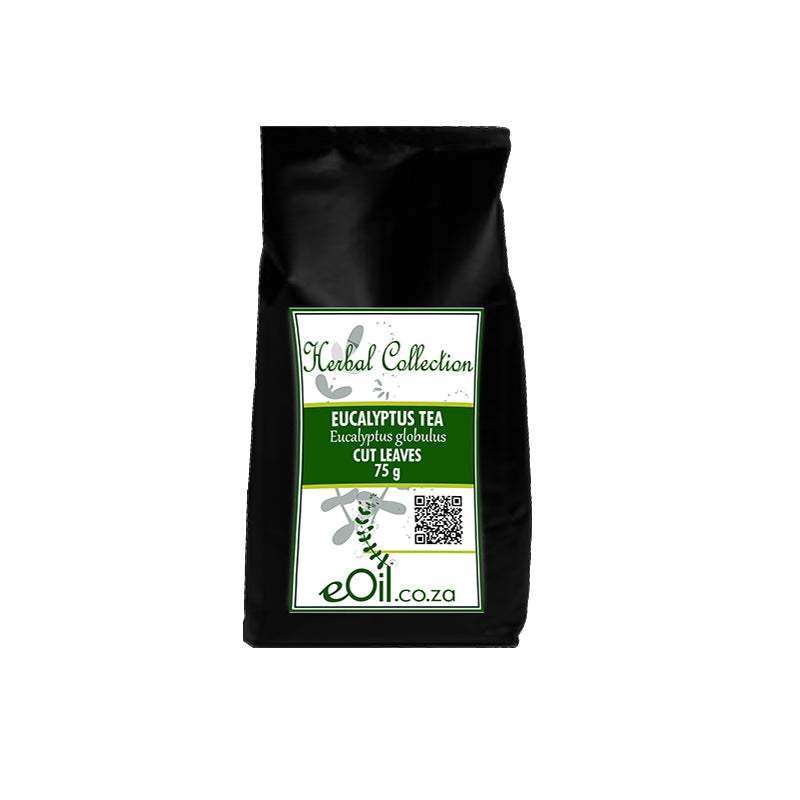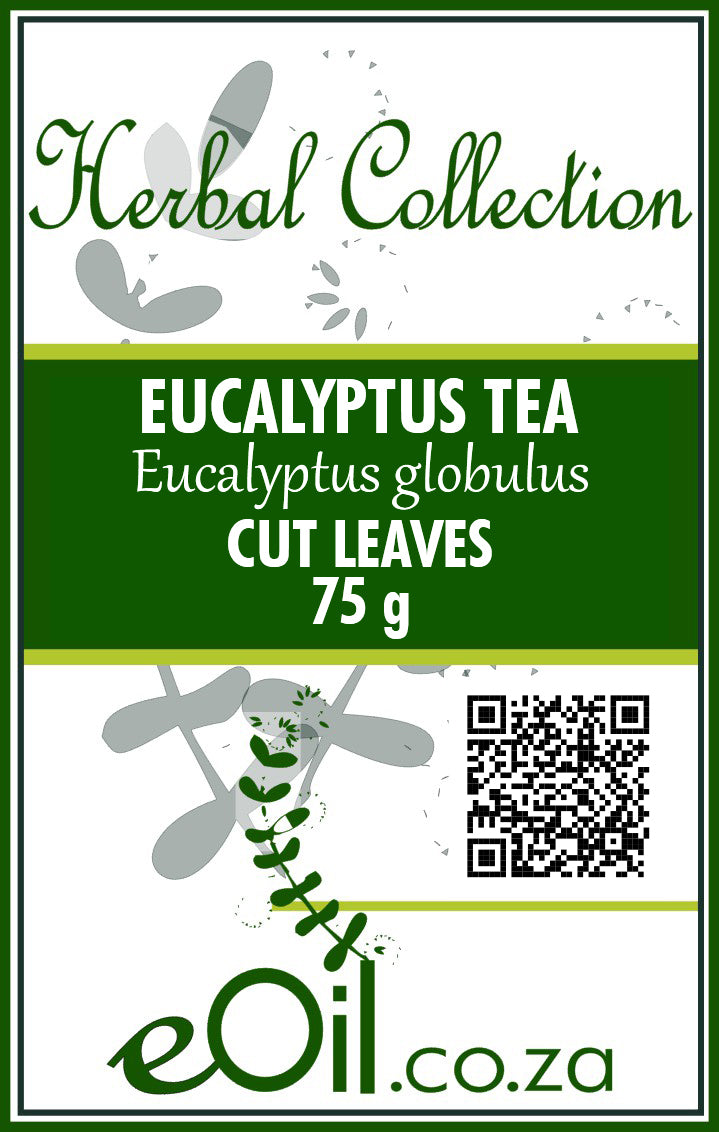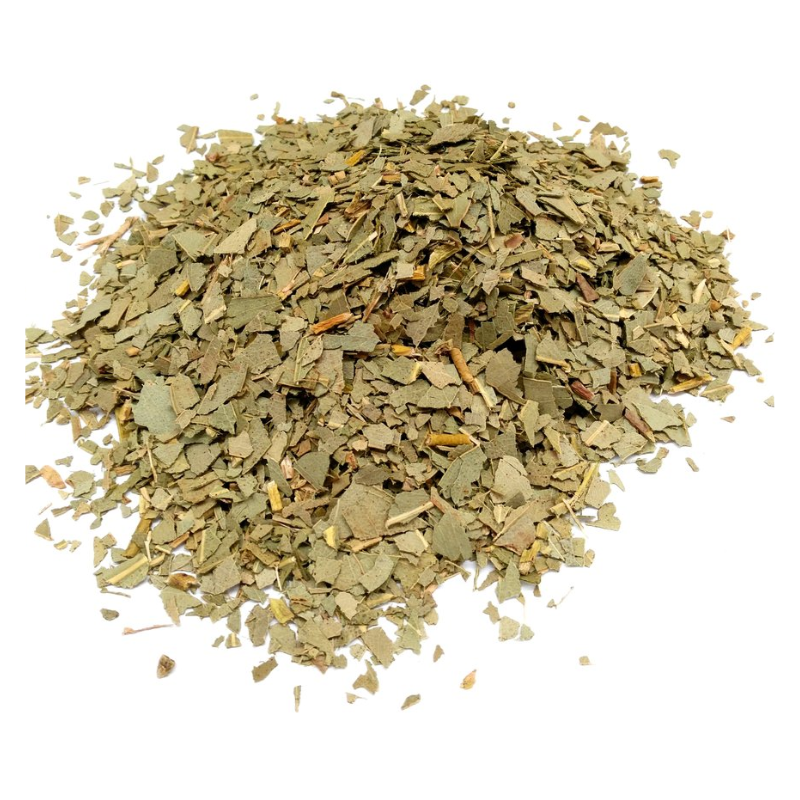Eucalyptus leaves cut - Herbal Collection
Eucalyptus leaves cut - Herbal Collection - 75 GR is backordered and will ship as soon as it is back in stock.
Description
Description
Eucalyptus Leaves Cut (Eucalyptus globulus) are sun-dried, slender, aromatic leaves known for their invigorating, camphor-like fragrance.
Ideal for herbal teas, potpourri, bath blends, sachets, and natural décor. These pure, plant-based leaves are versatile in home and wellness routines.
TRADITIONALLY USED FOR
Eucalyptus leaves tisane, also known as eucalyptus tea, is an herbal infusion made from the leaves of the eucalyptus tree (Eucalyptus globulus).
This aromatic plant is native to Australia and is now widely cultivated in various parts of the world.
Eucalyptus leaves contain various bioactive compounds that contribute to their potential health benefits.
Some potential properties and benefits of eucalyptus leaves tisane include:
- Respiratory health: Eucalyptus leaves contain a compound called eucalyptol (1,8-cineole), which has been shown to possess anti-inflammatory, antispasmodic, and expectorant properties. Drinking eucalyptus tea may help relieve symptoms of respiratory conditions such as asthma, bronchitis, and the common cold by reducing inflammation and mucus production.
- Immune support: Eucalyptus leaves have antioxidant and antimicrobial properties, which may help support the immune system and protect against infections.
- Pain relief: Some studies suggest that eucalyptus may have analgesic (pain-relieving) properties, making it a potential natural remedy for headaches, muscle pain, and arthritis.
- Dental health: The antimicrobial properties of eucalyptus leaves can help reduce the buildup of bacteria that cause bad breath and gum disease.
- Stress relief: Eucalyptus tea has a soothing aroma that may help reduce stress and anxiety. Drinking a cup of this tea can provide a sense of relaxation and well-being.
- Skin health: Applying cooled eucalyptus tea to the skin may help alleviate inflammation, irritation, and itching associated with conditions such as eczema, psoriasis, and insect bites.
While eucalyptus tea offers various potential benefits, it is essential to note that more research is needed to fully understand its effects. As with any herbal remedy, it is crucial to consult a healthcare professional before using eucalyptus leaves tisane, especially if you are pregnant, breastfeeding, or taking medication. Additionally, eucalyptus can be toxic if consumed in excessive amounts, so always follow the recommended dosage and preparation instructions.
INFORMATION
Source : http://www.wikiphyto.org/wiki/Eucalyptus_globuleux
Reference on http://www.wikiphyto.org
Translation in English by Google Translate (go to the page of the source linked | on Chrome cellphones go on the 3 dots on the top right and select translate in your preferred language | on laptop right click your mouse and select option translate when hoovering on the page
plant name
Globulous eucalyptus, Tasmanian blue gum , kinimpotsy or kininimpotsy (Malagasy)
International Latin denomination
Eucalyptus globulus Labill.
botanical family
Myrtaceae
Description and habitat
- Beautiful ornamental tree native to South Australia and Tasmania, introduced to most countries with warm temperate climates (Spain, Portugal, Australia)
- Large in size, 30 meters in height (and up to 100 meters in Australia)
- Smooth, ashy trunk, evergreen, oval and opposite leaves on young twigs, sickle-shaped, leathery, alternate on older twigs
- The flowers form a small box opening with a lid: the stamens are enclosed in a case closed by an operculum (hence the name eucalyptus from the Greek eu = well and kaluptos = covered) formed by the fusion of the petals and /or sepals
History and tradition
- Sanitizes marshy areas, due to its ability to absorb water, it would have kept malaria away in Italy and the South of France
- In all the countries where it grows, its sickle-shaped leaves are used as an antiseptic for the sinuses, nasopharynx and lungs.
- Label. comes from the name of Labillardière who discovered it in 1800 during a trip to Australia
Parts used
- Leaves of old twigs, leaf essential oil
Dosage forms available
- Leaf tincture
- leaf essential oil
Usual dosages
- The German Commission E monograph [1] indicates a reference dose of 0.3 to 0.6 g/day of eucalyptus globulus essential oil , i.e. 240 to 480 mg/day of 1,8-cineole
- It is reasonable to stay below 300 mg of eucalyptus HE , not to exceed two weeks of treatment for doses of 150 to 300 mg, and not to exceed one month of treatment for doses lower than 150 mg, a dose of 75 mg of 1,8-cineole per day may seem safe
Composition
Main components of the plant
- Eucalyptol essential oil = 1,8 -cineole (70 to 75%)
- Tannins
- Numerous flavonoids ( pinocembrin ) [2]
- Beta-triketones
Main components of buds or young shoots
Main components of essential oil
- Terpene oxides : 1,8-cineole (70-75%)
- Monoterpenes : alpha-pinene (10-12%), limonene , gamma-terpinene , paracymene
- Sesquiterpenes : aromadendrene
- Sesquiterpenols : globulol , ledol
- Jensenone ( monoterpene ketone )
Properties
Plant properties
- Antiseptic of the respiratory tract, expectorant, anticatarrhal, for internal and external use, decongestant, hypoglycemic (?)
- Detoxifying action of diphtheria and tetanus toxins, antimicrobial on Gram + bacteria, antifungal [3] , ( Candida sp ) [4] , anti-inflammatory
- Improves respiratory function tests ( 1,8-cineole at a dose of 3 times 200mg/day)
- In asthma treated orally with 1,8-cineole capsules (3 times 200mg/day for 3 days), inhibition of the production of arachidonic acid metabolites (leukotriene B4 and prostaglandin E2) and monocytes [5]
- Anti-inflammatory by action on NO inhibition and antiradical effects [6]
- Antidiabetic [7] , decreases postprandial hyperglycemia and hyperfructosemia [8]
- Phenolic compounds show inhibitory activity of enzymes alpha-amylase, alpha-glucosidase, aldose reductase, angiotensin converting enzyme, dipeptidyl peptidase 4, which plays a pathogenic role in type II diabetes [9]
Bud properties
Properties of essential oil
- Antitussive, expectorant and mucolytic [10] , bronchial antispasmodic, febrifuge, very marked bronchopulmonary tropism, drying in a high proportion
- Antibacterial on Gram negative bacteria ( Escherichia coli ) and Gram positive bacteria ( Staphylococcus aureus ) [11] , even on multiresistant bacteria [12] , anti-biofilm activity against Proteus mirabilis [13] , marked inhibition of multiresistant bacteria such as methicillin- resistant Staphylococcus aureus (MRSA) [14] and vancomycin -resistant Enterococcus (VRE) [15] , antimicrobial against many bacteria, including Mycobacterium tuberculosis , Staphylococcus aureusmethicillin resistant (MRSA), virus, fungi ( Candida sp ). [16] , EO is effective in reducing bad odors in necrotic cancerous wounds, alone [17] , or mixed with tea tree and grapefruit EO [18]
- Immunostimulant [19] , increases innate immunity and humoral response [20]
- Antiviral [21] , [22] , [23] , anti-influenza by inhibiting hemagglutinin [24] , and when EO is incorporated into air filtration materials, or by aerosolization [ 25]
- Antifungal, activity on Trichosporon ovoides , agent of scalp mycosis, with Cymbopogon winterianus , Mentha piperita , Cinnamomum zeylanicum , Melaleuca alternifolia [26]
- Detoxifying diphtheria and tetanus toxins, antimicrobial (Gram + bacteria)
- Antioxidant [27]
- Analgesic and anti-inflammatory [28] , [29]
- Insecticide, effective against fleas, used in insecticidal collars for animals, and against lice [30] , mixed with HE of true lavender and peppermint [31]
- Essential oils from Myrtaceae are insecticides against the red flour beetle Tribolium castaneum [32] and another species, Tribolium confusum [33]
Directions
Indications of the whole plant (phytotherapy)
- Bronchitis, cough, asthma, COPD
- Pharyngitis, laryngitis
- Flu
- Rhinitis, otitis
Indications of the bud (gemmotherapy)
Specific indications of essential oil (aromatherapy)
- Bronchitis and bronchopneumopathies (COPD) [34] , cough, asthma, flu, pharyngitis, laryngitis, rhinitis, otitis
- 1,8 cineole , through its mucolytic, bronchodilator and anti-inflammatory effects, reduces exacerbation rate in patients with chronic obstructive pulmonary disease [35] , it also improves respiratory function and reduces dyspnea in asthmatic patients (multicenter double-blind study on 247 patients who received 200 mg of cineole or a placebo for 6 months, alongside usual treatments) [36]
- Local flea and lice repellent
Known or suspected mode of action
Usual formulations
- Suppositories for adults and children over 30 months
- Drinkable drops, mixed with other essential oils
Regulations
- French Pharmacopoeia list A (sheet)
Possible side effects and precautions for use
- Good tolerance in general
- Mild and rare side effects such as heartburn, nausea, vomiting, diarrhea
- HE by mouth: possible general reaction with shock, decrease in blood pressure and rapid pulse
- 1 ml of eucalyptus EO causes convulsions in humans [37]
- According to the EMA, the lethal dose for adults is 4-5 ml of eucalyptus essential oil .
- Oral poisoning with eucalyptus leaves is very unlikely (more than 100 g of leaves would be needed)
- The use of pure essential oil per os is not recommended in children, it may be responsible for loss of consciousness [38] , seizures at high doses, but the toxicity seems to have been overestimated [39]
- Inhalation of essential oil could lead to irritation of the nasal mucosa, even closure of the glottis in infants (same as menthol and camphor )
- Rare drug interactions
- Avoid in pregnant women
- HE by local route: possibility of allergic skin reaction
Bibliographic references
- Aller↑ List of German Commission E Monographs (Phytotherapy) [1]
- Aller↑ Goodger JQ, Seneratne SL, Nicolle D, Woodrow IE. Foliar Essential Oil Glands of Eucalyptus Subgenus Eucalyptus (Myrtaceae) Are a Rich Source of Flavonoids and Related Non-Volatile Constituents. PLoS One. 2016 Mar 15;11(3):e0151432. doi: 10.1371/journal.pone.0151432. eCollection 2016. PMID 26977933
- Aller↑ Musyimi, DM, & Ogur, JA (2008). Comparative assessment of antifungal activity of extracts from Eucalyptus globulus and Eucalyptus citriodora. Research Journal of Phytochemistry, 2008, Volume: 2, Issue: 1, Page No.: 35-43
- Aller↑ Noumi, E., Snoussi, M., Hajlaoui, H., Trabelsi, N., Ksouri, R., Valentin, E., & Bakhrouf, A. (2011). Chemical composition, antioxidant and antifungal potential of Melaleuca alternifolia (tea tree) and Eucalyptus globulus essential oils against oral Candida species. Journal of Medicinal Plants Research, 5(17), 4147-4156.
- Aller↑ Juergens UR, Stöber M, Schmidt-Schilling L, Kleuver T, Vetter H. Antiinflammatory effects of euclyptol (1.8-cineole) in bronchial asthma: inhibition of arachidonic acid metabolism in human blood monocytes ex vivo. Eur J Med Res. 1998 Sep 17;3(9):407-12. PMID 9737886
- Aller↑ Vigo E, Cepeda A, Gualillo O, Perez-Fernandez R. In-vitro anti-inflammatory effect of Eucalyptus globulus and Thymus vulgaris: nitric oxide inhibition in J774A.1 murine macrophages. J Pharm Pharmacol. 2004 Feb;56(2):257-63. PMID 15005885
- Aller↑ Gray AM, Flatt PR. Antihyperglycemic actions of Eucalyptus globulus (Eucalyptus) are associated with pancreatic and extra-pancreatic effects in mice. J Nutr. 1998 Dec;128(12):2319-23. PMID 9868176 Full Text: [2]
- Aller↑ Sugimoto K, Hosotani T, Kawasaki T, Nakagawa K, Hayashi S, Nakano Y, Inui H, Yamanouchi T. Eucalyptus leaf extract suppresses the postprandial elevation of portal, cardiac and peripheral fructose concentrations after sucrose ingestion in rats. J Clin Biochem Nutr. 2010 May;46(3):205-11. PMID 20490315 full text: [3]
- Aller↑ Dey B, Mitra A, Katakam P, Singla RK. Exploration of natural enzyme inhibitors with hypoglycemic potentials amongst Eucalyptus Spp. by in vitro assays. World J Diabetes. 2014 Apr 15;5(2):209-18. doi: 10.4239/wjd.v5.i2.209. PMID 24748933
- Aller↑ Boukhatem, MN, Ferhat, MA, Kameli, A. et al. Eucalyptus globulus (Labill.): a gasoline tree with a thousand virtues. Phytotherapy (2017). https://doi.org/10.1007/s10298-017-1114-3
- Aller↑ Bachir RG, Benali M. Antibacterial activity of the essential oils from the leaves of Eucalyptus globulus against Escherichia coli and Staphylococcus aureus. Asian Pacific Journal of Tropical Biomedicine. 2012;2(9):739-742. doi:10.1016/S2221-1691(12)60220-2. Full Text
- Aller↑ Mulyaningsih S, Sporer F, Reichling J, Wink M. Antibacterial activity of essential oils from Eucalyptus and of selected components against multidrug-resistant bacterial pathogens. Pharm Biol. 2011 Sep;49(9):893-9. doi: 10.3109/13880209.2011.553625. PMID 21591991
- Aller↑ Mathur S, Udgire M, Khambhapati A, Paul D. Anti-biofilm activity and bioactive component analysis of eucalyptus oil against urinary tract pathogen. Int. J. Curr. Microbiol. App. Sci (2014) 3(5): 912-918 full text
- Aller↑ Tohidpour A, Sattari M, Omidbaigi R, Yadegar A, Nazemi J. Antibacterial effect of essential oils from two medicinal plants against Methicillin-resistant Staphylococcus aureus (MRSA). Phytomedicine. 2010 Feb;17(2):142-5. doi: 10.1016/j.phymed.2009.05.007. PMID 19576738
- Aller↑ Mulyaningsih S, Sporer F, Zimmermann S, Reichling J, Wink M. Synergistic properties of the terpenoids aromadendrene and 1,8-cineole from the essential oil of Eucalyptus globulus against antibiotic-susceptible and antibiotic-resistant pathogens. Phytomedicine. 2010 Nov;17(13):1061-6. doi: 10.1016/j.phymed.2010.06.018. PMID 20727725
- Aller↑ Sadlon AE, Lamson DW. Immune-modifying and antimicrobial effects of Eucalyptus oil and simple inhalation devices. Altern Med Rev. 2010 Apr;15(1):33-47. PMID 20359267
- Aller↑ Warnke, PH, Sherry, E., Russo, PA, Açil, Y., Wiltfang, J., Sivananthan, S., Sprengel, M., Roldàn, JC, Schubert, S., Bredee, JP, & Springer, IN (2006). Antibacterial essential oils in malodorous cancer patients: clinical observations in 30 patients. Phytomedicine: international journal of phytotherapy and phytopharmacology, 13(7), 463–467. https://doi.org/10.1016/j.phymed.2005.09.012 PMID 16785038
- Aller↑ Warnke PH, Terheyden H, Açil Y, Springer IN, Sherry E, Reynolds M, Russo PA, Bredee JP, Podschun R. Tumor smell reduction with antibacterial essential oils. Cancer. 2004 Feb 15;100(4):879-80. doi: 10.1002/cncr.20020. PMID 14770448
- Aller↑ S. R. Rehman, K. Muhammad, T. Yaqub, M. S. Khan, K. Hanif, R. Yasmeen. Antimicrobial activity of mentofin and its effect on antibody response of broilers to newcastle disease virus vaccine. The Journal of Animal & Plant Sciences, 23(4): 2013, Page: 1008-1011 full text
- Aller↑ Awaad, MHH; Abdel-Alim, GA; Sayed, KSS; Kawkab; Ahmed, A.; Nada, AA; Metwalli, ASZ; Alkhalaf, AN Immunostimulant effects of essential oils of peppermint and eucalyptus in chickens. Pakistan Veterinary Journal 2010 Vol. 30 No. 2 pp. 61-66 agris.fao.org
- Aller↑ Ameur Elaissi, Zyed Rouis, Nabil Abid Ben Salem, Samia Mabrouk, Youssef ben Salem, Karima Bel Haj Salah, Mahjoub Aouni, Farhat Farhat, Rachid Chemli, Fethia Harzallah-Skhiri, Mohamed Larbi Khouja. Chemical composition of 8 eucalyptus species' essential oils and the evaluation of their antibacterial, antifungal and antiviral activities. BMC Complementary and Alternative Medicine 2012, 12:81 doi:10.1186/1472-6882-12-81 full text
- Aller↑ A. Astani, J. Reichling, P. Schnitzler. (2010). Comparative study on the antiviral activity of selected monoterpenes derived from essential oils. Phytotherapy Research: An International Journal Devoted to Pharmacological and Toxicological Evaluation of Natural Product Derivatives. 24(5): 673-679.
- Aller↑ Schnitzler, Paul & Astani, Akram & Reichling, Jürgen. (2010). Antiviral Effects of Plant-Derived Essential Oils and Pure Oil Components. Lipids and Essential Oils as Antimicrobial Agents. 239-254. 10.1002/9780470976623.ch10. PMID 32516954
- Aller↑ Vimalanathan, Selvarani. (2014). Anti-influenza virus activity of essential oils and vapors. American Journal of Essential Oils and Natural Products. 2. 47-53.
- Aller↑ Pyankov, Oleg & Usachev, Evgeny & Pyankova, Olga & Agranovski, Igor. (2012). Inactivation of Airborne Influenza Virus by Tea Tree and Eucalyptus Oils. Aerosol Science and Technology - AEROSOL SCI TECH. 46. 10.1080/02786826.2012.708948.
- Aller↑ Seema Saxena, Veena Uniyal, RPBhatt. Inhibitory effect of essential oils against Trichosporon ovoides causing piedra hair infection. Brazilian Journal of Microbiology (2012): 1347-1354. PMID 24031963
- Aller↑ Akolade Jubril Olayinka, Olajide Olutayo Olawumi, Afolayan Michael Olalekan, Akande Sarah Abimbola, Idowu Doyinsola Idiat, Orishadipe Abayomi Theophilus. Chemical composition, antioxidant and cytotoxic effects of Eucalyptus globulus grown in north-central Nigeria. J.Nat. production Plant Resour., 2012, 2 (1):1-8 full text
- Aller↑ Silva J, Abebe W, Sousa SM, Duarte VG, Machado MI, Matos FJ. Analgesic and anti-inflammatory effects of essential oils of Eucalyptus. J Ethnopharmacol. 2003 Dec;89(2-3):277-83. PMID 14611892
- Aller↑ Hayat, U., Jilani, MI, Rehman, R., & Nadeem, F. (2015). A Review on Eucalyptus globulus: A New Perspective in Therapeutics. International Journal of Chemical and Biochemical Sciences, 8, 85-91.
- Aller↑ Toloza AC, Lucia A, Zerba E, Masuh H, Picollo MI. Eucalyptus essential oil toxicity against permethrin-resistant Pediculus humanus capitis (Phthiraptera: Pediculidae). Parasitol Res. 2010 Jan;106(2):409-14. PMID 19902249
- Aller↑ Gonzalez Audino P, Vassena C, Zerba E, Picollo M. Effectiveness of lotions based on essential oils from aromatic plants against permethrin resistant Pediculus humanus capitis. Arch Dermatol Res. 2007 Oct;299(8):389-92. PMID 17647002
- Aller↑ Saima Siddique, Zahida Parveen, Firdaus-e-Bareen, Abida Butt, Muhammad Nawaz Chaudhary, Muhammad Akram. Chemical Composition and Insecticidal Activities of Essential Oils of Myrtaceae against Tribolium castaneum (Coleoptera: Tenebrionidae). Pol. J. About. Stud. 2017;26(4):1653–1662. DOI: https://doi.org/10.15244/pjoes/73800
- Aller↑ Serafina Russo, Nora Cabrera, Hugo Chludil, Margarita Yaber-Grass, Silvia Leicach. Insecticidal activity of young and mature leaves essential oil from Eucalyptus globulus Labill. against Tribolium confusum Jacquelin du Val (Coleoptera: Tenebrionidae). Chilean Journal of Agricultural Research 75(3) July-September 2015, 375-379
- Aller↑ Chen HY, Ma CH, Cao KJ, Chung-Man Ho J, Ziea E, Wong VT, Zhang ZJ. A systematic review and meta-analysis of herbal medicine on chronic obstructive pulmonary diseases. Evid Based Complement Alternate Med. 2014;2014:925069. doi: 10.1155/2014/925069. PMID 24795773
- Aller↑ Worth, H., Schacher, C., & Dethlefsen, U. (2009). Concomitant therapy with Cineole (Eucalyptole) reduces exacerbations in COPD: a placebo-controlled double-blind trial. Respiratory research, 10(1), 69. https://doi.org/10.1186/1465-9921-10-69 PMID 19624838
- Aller↑ Worth H, Dethlefsen U. Patients with asthma benefit from concomitant therapy with cineole: a placebo-controlled, double-blind trial. J Asthma. 2012 Oct;49(8):849-53. doi: 10.3109/02770903.2012.717657. PMID 22978309
- Aller↑ Poppenga RH. Risks associated with the use of herbs and other dietary supplements. Vet Clin North Am Equine Pract. 2001 Dec;17(3):455-77, vi-vii. PMID 11780280
- Aller↑ Tibballs J. Clinical effects and management of eucalyptus oil ingestion in infants and young children. Med J Aust. 1995 Aug 21;163(4):177-80. PMID 7651249
- Aller↑ Webb NJ, Pitt WR. Eucalyptus oil poisoning in childhood: 41 cases in south-east Queensland. J Pediatr Child Health. 1993 Oct;29(5):368-71. PMID 8240865
- Schilcher, H. Phytotherapie in der Kinderheilkunde – Handbuch für Ärzte und Apotheker. Wissenschaftliche Verlagsgesellschaft mbH Stuttgart: 3. Auflage, ISBN 3-8047-1644-X; stuttgart. 1999.
- Schnitzler P, Schon K, Reichling J. Antiviral activity of Australian tea-tree oil and eucalyptus oil against herpes simplex virus in cell culture. Pharmacy. 2001. 56: 343-347. http://www.ncbi.nlm.nih.gov/pubmed/11338678
- Pauli A, Schilcher H. Specific Selection of Essential Oil Compounds for Treatment of Children's Infection Diseases. Review. Pharmaceuticals 2004, 1, 1-30. http://www.mdpi.net/pharmaceuticals/papers/pharm01010001.pdf
- ESCOP. Eucalypti Aetheroleum. Eucalyptus oil. ESCOP Monographs: the Scientific Foundations for Herbal Medicinal Products. Second Edition completely revised and expanded. Stuttgart: Georg Thieme, 2003b, pp. 150-156
CAUTION
Store in a cool, dry place, away from light. Keep tightly closed, away from the reach of Children and pets.
Do not exceed the daily dose.
This product is not intended to prevent or cure any form of illness or disease.
If you are pregnant or nursing ; If you have a medical condition or are in the course of medical treatment ; If you are programmed for theater/operation in the near future, please consult your healthcare practitioner before using this product.
This product cannot replace a varied and balanced diet and a healthy lifestyle.
This product has not been evaluated by the SAHPRA for its quality, safety or intended use.
For More Information please check our General Safety Herbal products Page

Eucalyptus leaves cut - Herbal Collection - 75 GR is backordered and will ship as soon as it is back in stock.





